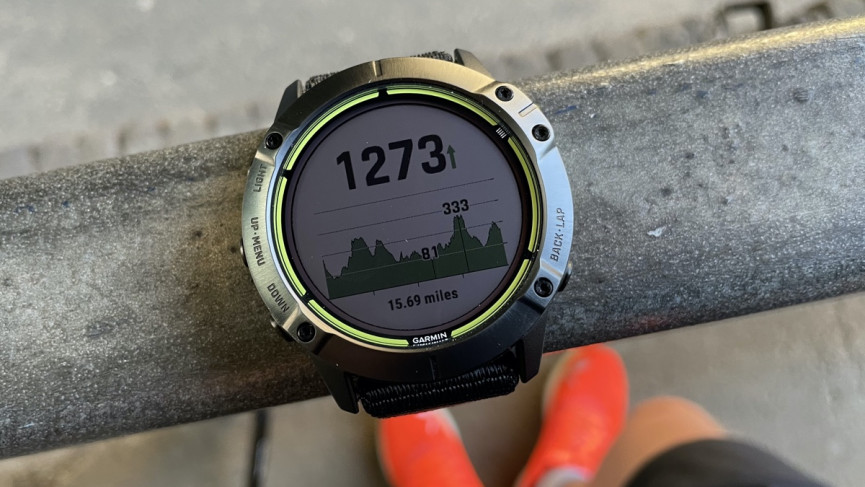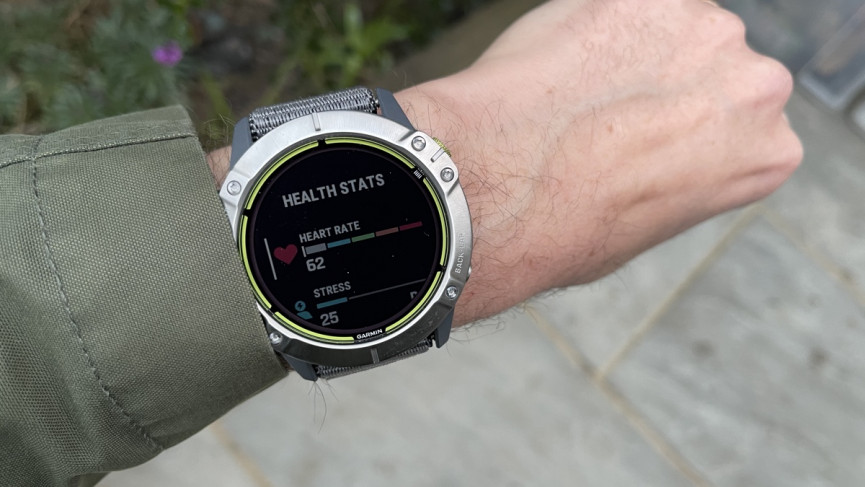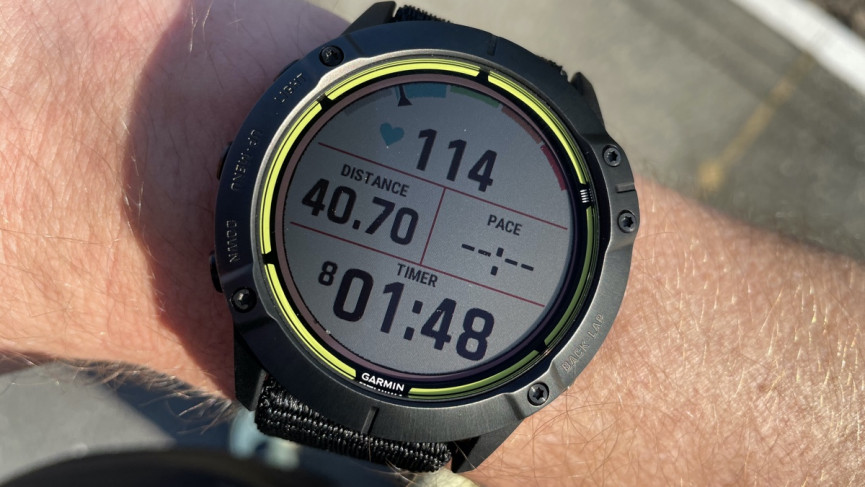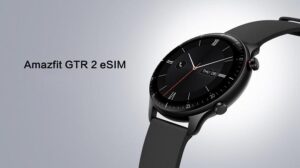As the saying goes, after you turn left on the plane and fly in business class, you can never go back. And with incredible battery performance, the Garmin Enduro is the equivalent of a sports watch; once you experience its epic longevity, you won’t be looking back.
At its basic level, the Enduro is essentially a variation on the Fenix 6X. It has all the multisport tracking, fitness monitoring, navigation, and smartwatches you’d find in a Garmin adventure watch, but with even more battery life, solar charging, and several unique features designed for the hiking lifestyle.
Price when considering:
£ 699
It is part of the elite sports watch group but eclipses the Polar Vantage V2, Suunto 9 Baro, and Garmin’s own Instinct Solar.
But it also outshines the competition on price. Starting at £ 699, it is on par with the most expensive sports watch. It sits somewhere in the middle of the Fenix 6’s price range – not the pretty whopping £ 899 you’d pay for the Fenix 6X Pro Solar, but a lot more expensive than the cheapest Fenix 6S (£ 529). That is a significant investment
And a titanium version of the Enduro, which costs £ 799.
Critical features of Garmin Enduro
Price: £ 699
Available in steel or titanium with DLC
GPS battery for 80 hours, expandable up to 300 in full power modes with a solar storm.
1.4-inch 280 x 280 transflective display
Size: 51 x 51 x 14.9mm
V02 Max trail corrected
Ultra Run Mode with Separate Tracking of Help Stations
Grit and MTB Consumption Data
Triathlon mode
Interchangeable straps 26 mm
Water-resistant up to 100 m
Solar charger

The phrase “game-changer” is overused in technical circles, but the Enduro battery deserves the nickname.
Even without the ability to harvest the sun’s rays for extra power, the Enduro raises the bar for what we now expect from any sports watch.
On paper, Enduro claims up to 70 hours of GPS battery life and up to 200 hours in hibernation mode – this increases to 80 and 300 hours with the Power Glass solar display, which uses the sun to boost the Enduro’s endurance in the right lighting conditions.
The Smartwatch’s claimed full use is 50 days, and there is also an expedition mode that stretches to 65 days. Again, they both can be solar-scaled.
Enduro battery life:
The Smartwatch: up to 50 days / 65 days with solar battery
Complete GPS: up to 70 hours / 80 hours with solar battery
The maximum battery in GPS mode: up to 200 hours / 300 hours with solar battery
Expeditionary GPS activity: up to 65 days / 95 days with solar
The Enduro’s battery life lags far behind Garmin’s competitors. Only the Coros Vertix is currently getting close, and it only picks up 60 hours of complete GPS and 120 hours in hibernation mode. Next comes the Polar V2 with 40 hours of complete GPS and 100 hours of low GPS mode.
In tests, this was pretty much in line with billing. There are 31 days of use on a single charge and over 30 hours of training, covering a mix of indoor and outdoor activities with GPS tracking.
On average, an hour of GPS training burns no more than 1%. 8-hour 40-mile full GPS ultra-running test burned just 10%. In 3 hours of work in UltraTrac mode, you lost only 1%.
Using smartwatches without training contradicts Garmin’s claims a bit. 25% of the battery in 9 days, which equates to approximately 36 days on a single charge with regular use. Although during testing, if to play with the watch more often than usual. Without the pulse oximeter turned on, the intensity of combustion per night averaged 1%.
It was tested where 24/7 blood oxygen monitoring without constant charging is a viable option. Even with the blood oxygen sensor on and consuming a lot of battery power, the Enduro still only drained 22% of its battery in four days. Much better performance than the Fenix 6 Pro, which has double the leak rate.

It was tested enduro solar charging if to leave it lying on our patio in direct daylight for 8 hours, and he added 1%.
Putting the Enduro’s battery life in context will happily stand up to multi-day ultra-high endurance tests like the Marathon des SablesHe will also happily track a 10-kilometer run of a month. Run, ride or swim for an hour a day could potentially only need to charge the Enduro a dozen times a year.
It is wonderful. That is the closest thing to getting rid of worry about battery life. You can be up 4% and still confidently go on a two-hour trip.
This incredible endurance also benefits from the intelligent Power Manager tool, which displays estimated energy savings using sensors and features. You can see what is worth the most power and adjust accordingly by creating and saving custom power modes to extend battery life.
Before you try this never-dying battery, it’s pretty easy to write it off as overkill. After all, plugging in a watch for charging is not so difficult. But as with the upper class on an airplane, after experiencing such good battery life, it’s hard to go back to something that requires a daily charge (Apple Watch) or even weekly (most sound if you can afford it – or ask someone to pay for it – it’s a luxury worth having.
Besides the seductive lime detail on the bezel and matching pusher on the crown, you will have difficulty distinguishing the Enduro from the Fenix 6X. It is as if color flashes appear for this very reason. But overall, this is a beautiful watch with good construction.
It has the same rugged design, the same low-resolution 280 x 280 color transflective LCD, and the same massive 51mm body. Like the Fenix, this watch will grip the wrists, although, at 56-72g, it’s noticeably lighter than the 93g Fenix 6X Pro.
If a wrist can handle a vast screen, this weight saving makes it more comfortable to wear around the clock than the Fenix - there’s no getting away from it; this is a big watch.

The Enduro comes in two stainless steel versions and is £ 100 more expensive, lighter, stronger, and more scratch-resistant in Diamond-Like Carbon (DLC) coated titanium. Both have fiber-reinforced polymer cases and metal back covers. We tested the titanium DLC, after eight weeks, it still looks new.
The stainless steel version, which was found bit into the wrist a bit and rubbed against the bone. If you have skinny wrists, titanium can be a wise investment.
1.4-inch always-on color enduro screen is large, and the visuals are crisp. It brightens in sunlight, and we found it easy to read on the go as it can fit up to six indicators on a single screen. They, too, can be easily configured on the watch, not in the app.
Enduro replaces classic – sometimes skin-irritating – silicone straps with a comfortable UltraFit nylon strap. It adjusts on both sides rather than locks on one side, a fastening design that is a bit odd at first but helps find a more precise fit than the classic perforated bands. All in all, this is better suited for long-range missions than a regular belt. If to go back to silicone, the straps are 26mm in size and easily replaced.
Garmin Enduro Nylon Strap
The massive Enduro frame houses a full suite of Garmin sensors, including the same Elevate optical heart rate monitor on the Fenix 6, barometric altimeter, compass, gyroscope and thermometer, and a SpO2 pulse oximeter to monitor blood oxygen saturation. Bluetooth and ANT + connectivity means you can connect to a Peleton or Wattbike and use a chest strap at the same time.
Controls are standard on Garmin with five easy-to-use buttons that are responsive, easy to use on the go, and come with many shortcuts. It is waterproof up to 100 meters.
Garmin Enduro: sports tracks and wellness
Garmin Enduro health statistics
The Enduro is the ultimate all-rounder with dedicated activity modes for many sports, including running, cycling, stationary cycling, swimming (indoor and outdoor), mountain biking, hiking, strength training, and triathlon. Golf is well-served too.
Plus, it boasts all of the daily activity, sleep, stress, breathing, and wellness tools to see standard on Garmin devices. Considered hydration and menstrual tracking, but only in the Garmin Connect app. with daytime GPS tracking.
Resting heart rate is accurately tracked and injected into watch widgets like Body Battery and Stress Score, which help those with a busy workout schedule. Any spikes in any of the metrics could indicate that you may need a day off. And change your training schedule – and this data is more beneficial for enduro-like users where users will be heavily training their bodies than for the company—lifestyle watches.
Sleep tracking is decent, with sleep tracking – although the Enduro too bulky to be awake. The data is not as informative as Fitbit, which is considered to be the gold standard for sleep tracking.
Run

Garmin Enduro Run Mode
The Enduro embodies everything in the Garmin Forerunner watch line into a more robust, more durable design when it comes to running. There is a running profile, treadmill running, indoor running, trail running, Ultrarunning, and virtual running.
Several new endurance skills have also been introduced, targeting Ultra off-road trails. Ultra Run Mode with Smart Rest Timer determines how much time you spend lounging in the health center’s buffet. It’s effortless to use – indispensable for the 75km brain – and very revealing.
The visuals show that was spending too much time “breathing space” on ultra-runs. After a run, your active heart rate and active cadence are also separate from your regular stats.
Garmin Enduro vo2 max
There is also a new Vo2 Max rating; running VO2 Max is partially estimated using pace. Thus, runners who choose the path may find that a slower pace increases their VO2 Max. Garmin Enduro now adjusts your VO2 Max accordingly.
In tests, a VO2 Max score of 53 after one day’s mileage, the next day, if you run, and that value can be dropped to 49. Without costly portable oxygen exchange equipment and laboratory testing, this is not possible. To check the accuracy here. But it’s a welcome addition anyway and serves as a valuable way to measure your progress, especially if you’re heading off-road.
It’s worth noting that the trail-corrected VO2 Max also works in Ultrarunning mode. This way, you can have rest time and adjust VO2 Max if you choose Ultra.
The excellent Garmin ClimbPro feature now also includes descents and ascents. This way, you get the complete picture of the ATV burning that awaits you on your preloaded courses, including real-time information on current and upcoming ascents and descents based on gradient, distance, and altitude increase/decrease. A convenient tool for torment/motivation while racing. The brilliant auto-climb feature also lets you click on the dial to display your current climb statistics.
The training load, training effect, and training status all come with a run recovery advisor that tells you how long it takes before you fully recover to start training again.
Cycling and MTB

Cycling Vo2 max
Fenix synchronized Enduro’s cycling capabilities. Indoor and outdoor modes are covered, and Enduro is happy to receive data from third-party power meters, exercise bikes, and cadence sensors.
Mountain bikers can track mountain bike trails’ difficulties and technical specifics using specific sand and flow data. It will also remember your MTB runs and rate your performance, so you have something to beat next time.
Swimming
Due to the pandemic, it was unable to test the water performance of Enduro in a pool or open water. But the Enduro’s ability to swim is vast. All significant length, distance, pace, stroke counts are covered, plus automatic stroke detection, SWOLF swim estimation, workout logging, pace alerts, critical swim speed, and heart rate at the wrist underwater.
Suggested workouts
Launched initially on Forerunner 745: Featured Workouts uses your current training schedule and recovery status to recommend workouts aimed at improving overall fitness and preventing overtraining.
Security features
Another area in which Garmin sets the standard is in safety features. The Enduro offers a complete suite of real-time tracking and group tracking and activity alerts, and assistance alerts.
Garmin’s latest generation Elevate heart rate sensor supports fitness features such as Body Battery energy monitoring, advanced sleep monitoring, and stress tracking.

It also provides BPM readings for VO2 Max, training in heart rate zones, and heart rate alerts and streaming via Bluetooth and ANT +. You can use a chest strap to improve accuracy.
By the way, the Enduro performed well on most of our test runs and runs. We compared it to the Garmin HRM-Pro, Fenix 6 Pro Sapphire, Polar Vantage V2, and Polar’s new Verity Sense wearable optical tracker. Through a mixture of long ultra-low intensity runs, brisk intervals, big hill climbs, and progressive Wattbike rides. Plus strength training and unusual HIIT Bootcamp workouts.
In most cases, the optical sensor worked well. Most often, average and maximum heart rate values are compared, beats by beats. We only had one in a steady run during our ultra-40 mile race, where the Max was noticeably higher than the chest strap and V2, hitting 167 bpm versus 157 bpm.
That was not entirely the case for interval sessions with sudden jumps. As with most optical devices, the Enduro often sways and rises higher than our chest strap. As you do with almost all watches, it is recommended to use a chest strap to ensure maximum accuracy of all training and recovery analytics.
The daytime readings also matched those of other wrist-based heart rate monitors, and it also matched the chest strap for resting heart rate data.
Garmin Enduro: GPS Accuracy
GPS accuracy
The Enduro has GPS with GLONASS and Galileo satellite tracking support and UltraTrac power-saving mode.
That’s very reliable. Compared to the Fenix 6 Pro, Polar Vantage V2, and Stryd treadmill, the Enduro performed well over a range of distances, durations, and locations.
On a 40-mile forest ultra in full GPS mode, within half a mile of the Strid. The Vantage V2 added three extra miles. On many urban 10 km/sec, this was within a comfortable margin of error compared to the Strid.
The hibernation mode was slightly less expensive. In one extended test, the Enduro lost narrowly to the V2, hitting 15.5 miles versus the V2’s 18 miles. But in fact, the battery life of GPS at full power is so long that rarely needed to use UltraTrace mode.

Garmin Enduro: navigation features
One of the biggest criticisms Enduro faced at launch was the lack of maps. An ultra adventure watch without TOPO cards seems like an oversight.
You still get turn-by-turn navigation with the ability to create, download and follow routes. That is great for racing and the increasingly popular pastime in pursuit of the fastest known time. Plus point-to-point, back-to-start, and backtracking tools.
Garmin Enduro: smartwatch skills
Enduro has a wide range of smartwatch features. You get smartphone notifications (with text reply if you’re using Android), Garmin Pay contactless payments and weather forecasts, and access to additional apps, tools, faces, and widgets via Connect IQ.


